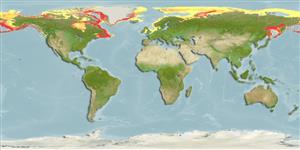Environment: milieu / climate zone / depth range / distribution range
Ecology
Marine; demersal; depth range 12 - 930 m (Ref. 58426), usually 125 - 150 m (Ref. 56590). Polar; -2°C - 8°C (Ref. 4698); 84°N - 45°N, 180°W - 180°E (Ref. 117245)
Arctic to Northwest Atlantic: Ungava Bay, Gulf of St. Lawrence in Canada and Greenland; Kara Sea and southeastern part of Barents Sea (Ref. 4698).
Size / Weight / Age
Maturity: Lm ? range ? - ? cm
Max length : 21.0 cm TL male/unsexed; (Ref. 56590); common length : 12.9 cm TL male/unsexed; (Ref. 56590); max. published weight: 160.00 g (Ref. 56590); max. reported age: 7 years (Ref. 56590)
Dorsal spines (total): 8 - 9; Dorsal soft rays (total): 18 - 22; Anal spines: 0; Anal soft rays: 13 - 18. Young with 2 dark blotches on body, which break up into small dark brown spots in adults; spinous dorsal fin with 1-2 round dark patches, soft part with a few comparatively broad dark stripes; upper part of pectoral fin with transverse stripes; anal and pelvic fins colorless; caudal fin with irregular spots (Ref. 4698).
Found on sand or sandy-mud bottoms with stones with salinities of 24.7-34.2 ppt (Ref. 4698). Benthic (Ref. 58426). Feeds mainly large bottom invertebrates, rarely small mollusks (Ref. 4698).
Life cycle and mating behavior
Maturity | Reproduction | Spawning | Eggs | Fecundity | Larvae
Robins, C.R. and G.C. Ray, 1986. A field guide to Atlantic coast fishes of North America. Houghton Mifflin Company, Boston, U.S.A. 354 p. (Ref. 7251)
IUCN Red List Status (Ref. 130435: Version 2024-2)
Threat to humans
Harmless
Human uses
Fisheries: bycatch
Tools
Special reports
Download XML
Internet sources
Estimates based on models
Preferred temperature (Ref.
123201): -1.5 - 4.2, mean -0.5 °C (based on 376 cells).
Phylogenetic diversity index (Ref.
82804): PD
50 = 0.5000 [Uniqueness, from 0.5 = low to 2.0 = high].
Bayesian length-weight: a=0.00589 (0.00281 - 0.01234), b=3.15 (2.97 - 3.33), in cm total length, based on LWR estimates for this (Sub)family-body shape (Ref.
93245).
Trophic level (Ref.
69278): 3.9 ±0.5 se; based on diet studies.
Resilience (Ref.
120179): Medium, minimum population doubling time 1.4 - 4.4 years (Preliminary K or Fecundity.).
Fishing Vulnerability (Ref.
59153): Low vulnerability (11 of 100).
